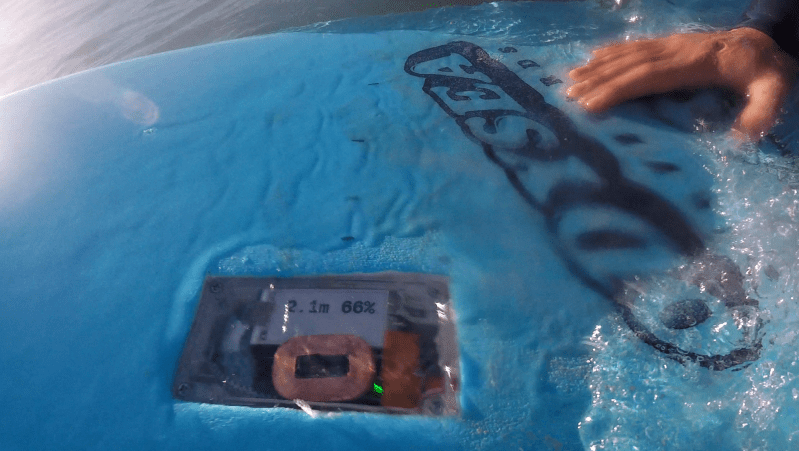To say that the ocean is a dynamic environment would be a gross understatement, especially when coastlines are involved. Waves crash, tides go in and out, and countless variables make even the usual conditions a guessing game. When [foobarbecue] goes surfing, he tries to take into account all of these things. The best waves at his local beach are directly over an ever-moving sand bar, and their dynamics are affected by depth, another constant variable. [foobarbecue]’s brilliant solution to understanding current conditions? Build a depth finder directly into his surf board!
At the heart of the “surfsonar” is the Ping Sonar Echosounder, a sonar transducer designed for AUV’s and ROV’s. [foobarbecue] embedded the transducer directly into the board. Data is fed to a Raspberry Pi 4b, which displays depth and confidence (a percentage of how sure it is of the measurement) on a 2.13 inch e-Paper Display Hat.
Power is provided by a PiSugar. Charging is done wirelessly, which we’d say is pretty important considering that the whole device is sealed inside a modified surfboard.
While it’s not a low budget build, and there’s yet room for improvement, early reports are positive. Once away from the breaking waves, the device confidently shows the depth. More testing will show if the surfsonar will help [foobarbecue] find that ever-moving sandbar!
Surf hacks are always welcome, we’ve featured the LED Strip Lit Surfboard as well as the Surf Window, which tells its owner if the surf is up. Be sure to let us know about any cool hacks you find when you’re out surfing the ‘net via our Tips Line!
















Nice, but maybe use an Arduino (or ESP if you need BT/WiFi) for longer runtimes? A Pi 4b seem seriously overpowered and also too big space-wise for this application…
Ah, the pleasure of a prototype. It just has to work. Optimizations can come later :)
Maybe you can even locate sandbars by a device that senses the particular behaviour of water particles in the top of the water column- they tend to start rising upward and then move over eachother as they approach shallower depths.. And call it the eyeball replacement device…
Just a minor point in the writing: “especially when coastlines are involved”
You do realize out in the middle of the atlantic there are pretty regularly 40-50 feet waves right?
Absolutely! The comment relates that near the coastline, there’s more than just the water moving around.
Perhaps an set of four ankle mounted vibration motors on each leg could provide direction and depth feedback. More vibration equals shallower water and some vector math could steer the user back to the last known shallow point, perhaps via multiple pulses of decreasing separation.
Dozens of surfers making sonar noises simultaneisly on the same beach ! Have you realy thought on the evronamental effects?
Fish don’t seem to mind when dozens of people use them in their bass boats in a given area.
This system is nothing like a sub’s sonar sweep….
Why a 4b? Thats like using the latest flagship GPU to play crossword puzzles…. Its like the scene is dominated by two types of people. 1) I can stack RPis and replace my desktop, right? Or 2) Im going to get the most expensive one because bigger number always means better, and only ever use it to read a temp sensor….
Maybe Im jaded. I have a hand full of old B boards, a mix of both 256 and 512, from a project to use them running effects, and triggerable shows, with DMX in haunted houses(like 15…around when they dropped…Sorry not sorry XD ). And they are comfortably handling every task I throw at them. One is a pihole and usb stream cam for the garage, another is a front yard facing camera (5mp 200°fov) and bme280 data source for my desk area, functions as an IR learner/blaster over the LAN, when I get my gps module working itll take on network base clock duties, its getting some smart leds as soon as I figure out what I want it to indicate, possibly servos for camera pan tilt zoom. And it rarely ever hiccups! Heck, I have a 3 thats my usual dev RPi, once the task and code are locked in it goes on an old B.
If you’re not asking for 800mhz of x86 performance out of them, and mind the ram ceiling, there is no damn reason to dedicate that kind of hardware to just reading a sensor….
That being said, I do love the installation and how it looks on the board. And wireless charging, friggin genius! A perfect use for that technology!